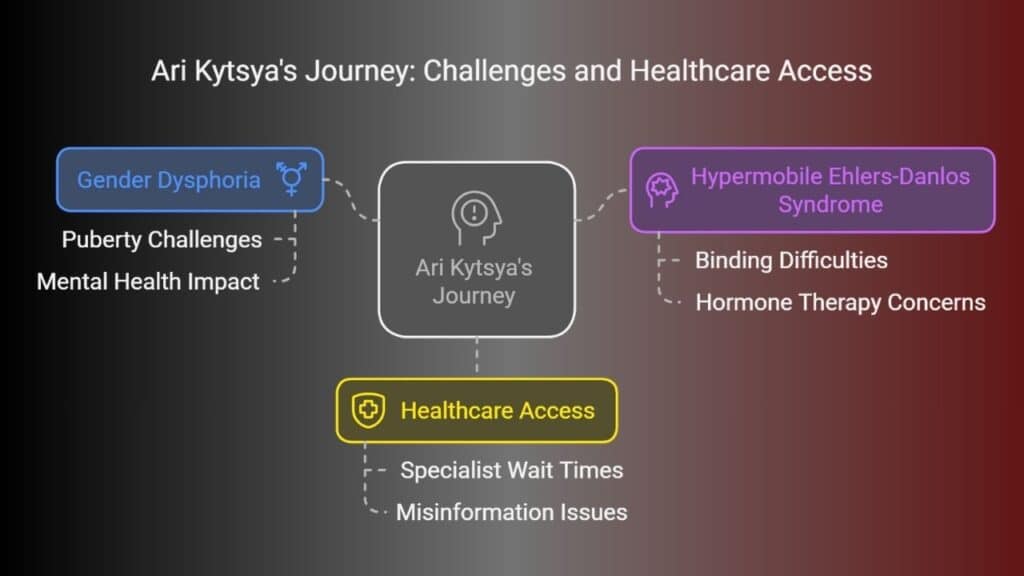Many people wonder about gender identity and what it means to be transgender. They ask questions like, “how much is vaginoplasty” and “is Ari Kytsya trans?” It’s not always easy to understand, but it’s important.
Ari Kytsya is someone who shares their story. They tell us about being non-binary and transgender.
Ari uses they/them pronouns. This fact shows us a bit about who they are. Our blog will help explain more about Ari’s life and gender identity. We will talk about what being non-binary and transgender means for them.
Keep reading to learn more.
Ari Kytsya’s Gender Identity
Ari Kytsya shares their truth as non-binary and trans. They opened up about their gender and asexuality journey at eighteen.
Identifying as non-binary
Ari Kytsya knows they are non-binary. This means they feel their gender is not just male or female. They use they/them pronouns to show who they are. Ari first thought they were agender, which means not having a gender.
But then, they found the word “non-binary” fit better for them. They like using androgyny to express themselves. Androgyny is when someone mixes qualities of both men and women in how they look or act.
They chose this way of expressing at 23 years old. Their journey shows it’s okay to find your own path with gender identity.
Coming out as transgender at eighteen
At eighteen, they openly said they were transgender. This age was a big moment for them. They felt right for the first time when they wore a binder. But, they learned they were too old for hormone blockers.
This news came at a time when understanding and accepting their true self was crucial.
They faced this new chapter with hope and some worries. The journey had just started, but it meant everything to them. It was more than changing how others saw them; it was about being true to themselves.
Navigating asexuality alongside gender identity
After announcing their transgender identity, Ari Kytsya came across another facet of their persona: being asexual. Social media platforms were a source of self-realization for them.
They acquired the understanding that individuality can have varied facets. Ari’s non-binary and asexual identity revealed to them the intricate layers of gender and attraction.
Ari noticed that some individuals hold rigid beliefs regarding what it means to be transgender or develop affections for others. Such preconceived notions posed increased difficulties for them.
Though, the realization of not being solitary in this emotional state was comforting. Via online platforms, Ari established connections with individuals undergoing similar experiences.
This shared understanding eased the process of comprehending their gender identity and asexuality.
Challenges Faced by Ari Kytsya
Ari Kytsya faced tough times with feelings of being in the wrong body and dealing with a rare health condition. They had to wait long for doctors who could help them become more comfortable in their skin.
Struggles with gender dysphoria
Ari faced tough times with gender dysphoria. This condition made them feel a mismatch between their body and their gender identity. It hit hard during puberty. Hormonal changes made depression worse.
Ari felt very sad and thought about suicide often because getting the right help took too long.
Their mental health suffered each time someone used the wrong gender words for them. Ari needed doctors who understand transgender people’s needs, but finding one was hard. The wait to see specialists in gender identity was too long, adding stress and pain to their life.
Next, we’ll look at how Hypermobile Ehlers-Danlos Syndrome affected Ari’s journey.
Impact of Hypermobile Ehlers-Danlos Syndrome on transition
After facing struggles with gender dysphoria, Ari also had to deal with Hypermobile Ehlers-Danlos Syndrome (HEDS) during their transition. HEDS made things like binding very hard. Binding is when someone flattens their chest to look more masculine.
But for Ari, this caused pain in the ribs and spine because of HEDS. This condition brings chronic pain and fatigue too.
Ari worried about starting hormone therapy because of possible side effects listed, such as acne and hair loss. These concerns are common for many transgender people looking at medical ways to transition.
Yet, for Ari with HEDS, these choices were even harder. They had to think a lot about how hormones might affect their already sensitive body due to HEDS.
Delays in accessing gender-affirming healthcare
Dealing with Hypermobile Ehlers-Danlos Syndrome already makes Ari’s journey harder. Then, getting to gender-affirming care adds another challenge. Ari faces long waits just to see a specialist.
This wait hurts mentally. It causes more stress and anxiety.
More doctors who know about gender health could make waits shorter. Sadly, there’s wrong info out there about how teens like Ari get help from their GPs for gender issues. This confusion makes things even slower for those in need.
Ari Kytsya’s Transition Journey
Ari Kytsya chose a new name during their journey, marking a fresh chapter in celebrating who they are.
Choosing a new name and its significance
Ari Kytsya searched baby name sites after their parents found out about them. They picked a name that felt right. This step was big for Ari. It showed who they are inside.
They told the university about their new name and pronouns too. This made life at school better for Ari. Changing a name is more than just new words. It means showing the true self to everyone.
Finding confidence at university to celebrate identity
University became a key place for feeling good about who they are. Here, they found friends who cared and used the right pronouns. This support made them feel brave to be themselves.
The environment at university helped a lot. It gave them the space to show their true self with pride. Friends played a big part in this journey, making the university days brighter and full of confidence.
Key considerations for transmasculine surgery aftercare
Ari Kytsya faced many challenges during their transition journey. They learned how key it is to plan for aftercare following transmasculine surgery.
- Keep the surgical area clean to avoid infection. This means gentle washing with soap and water.
- Wear post-op binders as advised by the surgeon. These help shape the chest and reduce swelling.
- Attend all follow-up appointments with healthcare providers. Doctors check healing and address any concerns.
- Take care of scars with proper treatments. Using special creams or gels can improve how scars look.
- Be aware of post-surgery risks like necrosis of the nipple graft. If signs show, see a doctor fast.
- Manage pain with medication prescribed by the doctor. Follow instructions on how much and when to take them.
- Allow enough time for recovery before returning to daily activities. Rushing can hurt healing.
Next, Ari Kytsya shares experiences dealing with healthcare after surgery.
Experiences with Healthcare
Ari Kytsya faced long waits to see specialists for gender identity. They also talked about the high costs of private doctors.
Positive relationship with their GP
Ari Kytsya felt good about their doctor. This doctor knew a lot about health care for transgender people. It’s important for doctors to learn more about this. Ari needed a doctor who understood them.
Their GP helped Ari get the right health care. Long waits for special gender services were hard, but the GP was supportive. This made things easier for Ari. The relationship with their GP shows why understanding and support matter in health care.
Criticism of long waiting times for gender identity services
Long waiting times for gender identity services make people feel hopeless and upset. Many wait months or even years for help. This delay worsens mental health issues. Ari Kytsya points out the need for more gender specialists to cut down on these long waits.
The slow system causes problems. It makes getting care hard for those who are already struggling. More specialists could make things faster and better for everyone involved. Now, let’s talk about the costs of private healthcare.
The financial burden of private healthcare
Private healthcare costs a lot. For someone like Ari, meetings with doctors about gender can cost between $250 and $350 each time. Before getting hormone treatments, Ari had to go to many of these expensive appointments.
The total was around $600 just to start treatment.
Ari thought these high prices and strict rules in private care were too much compared to NHS services. This made it hard for them to get the help they needed quickly and without spending too much money.
Social and Personal Insights
Ari Kytsya uses clothes to show who they are. They laugh at the odd ways they’ve had to tell people about their true self.
Learning to express identity through clothing
Ari found a way to show who they are with clothes. They started by choosing different shirts and using chest binders. This was important for them. It helped Ari feel more like themselves.
Their clothing choices were also shaped by HEDS. This condition made some clothes uncomfortable. So, Ari had to think about what they wore very carefully. Clothes became a big part of their story as a teenager facing stigma while exploring gender identity.
Frustrations with societal expectations of “transness”
Expressing identity through clothing lets Ari Kytsya show who they are. Yet, society has strict ideas about what being transgender means. These expectations do not match Ari’s experience.
They find it hard because people expect all transgender stories to be the same.
Ari feels upset by these narrow views. Many think you must follow a certain path if you’re trans. But Ari’s journey shows there are many ways to be transgender. The pressure to fit into a box makes things tough for them.
It proves we need to listen and learn from everyone’s unique stories.
A humorous anecdote about accidentally coming out
Ari was having fun with friends and had a bit too much to drink. In that moment, they shared their feelings about being transgender by accident. This slip led to an unexpected but very supportive response from their friends.
The whole thing turned into a funny story about how they came out.
This experience showed the light-hearted side of exploring personal identity. It also started more serious talks about gender among Ari and their friends. They found support in each other, making what could have been awkward, a special bonding time.
Now let’s move on to the next topic.
Takeaways
Ari Kytsya tells us they are non-binary and transgender. They shared their tough journey, from choosing a new name to facing health care woes. Ari’s story teaches the importance of being true to oneself.
It shows that change starts with us and our actions. Are you ready to support people like Ari? We can all help by understanding and respecting each one’s identity choice. Let’s make a space where everyone feels safe to be themselves.





































